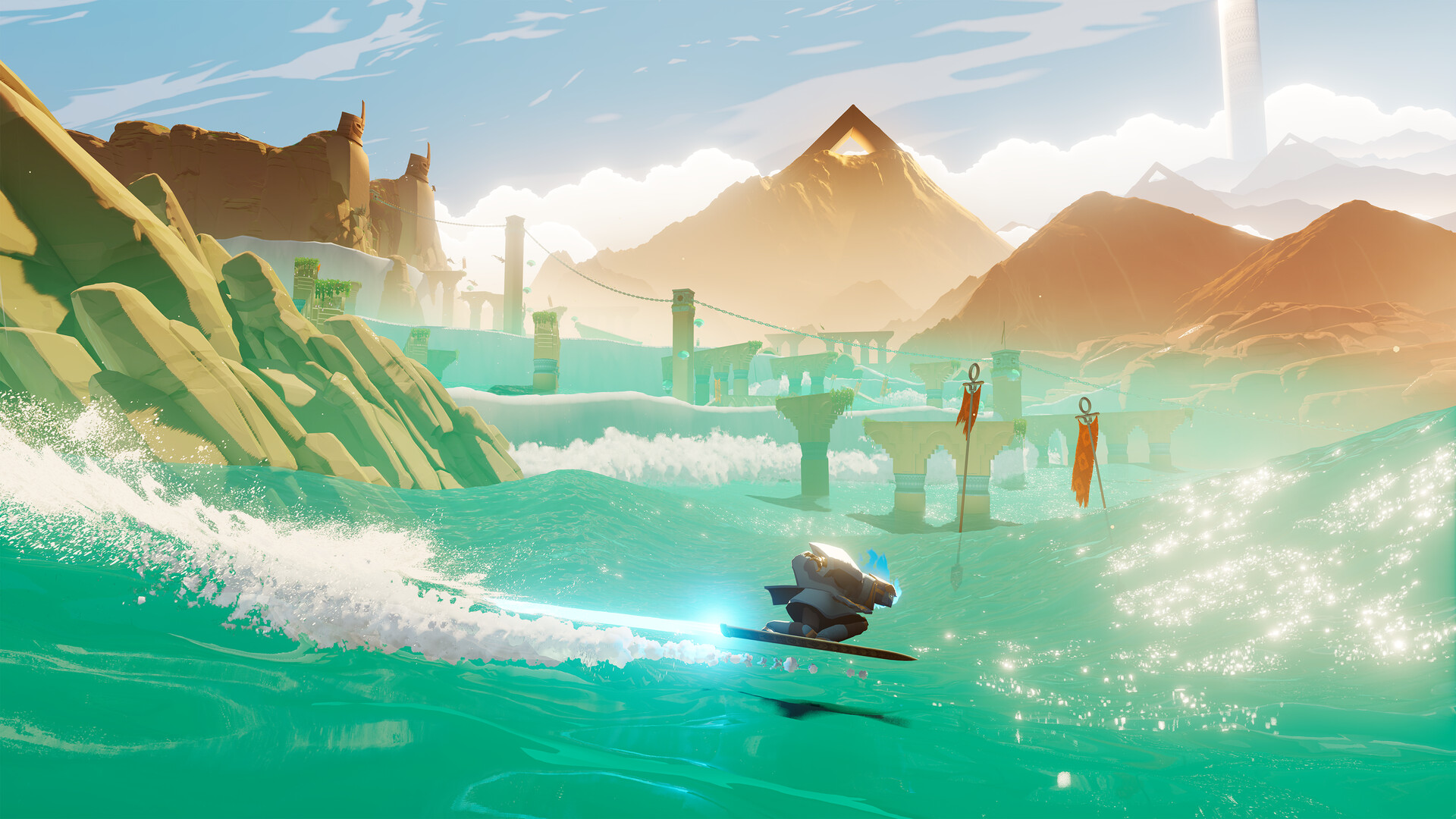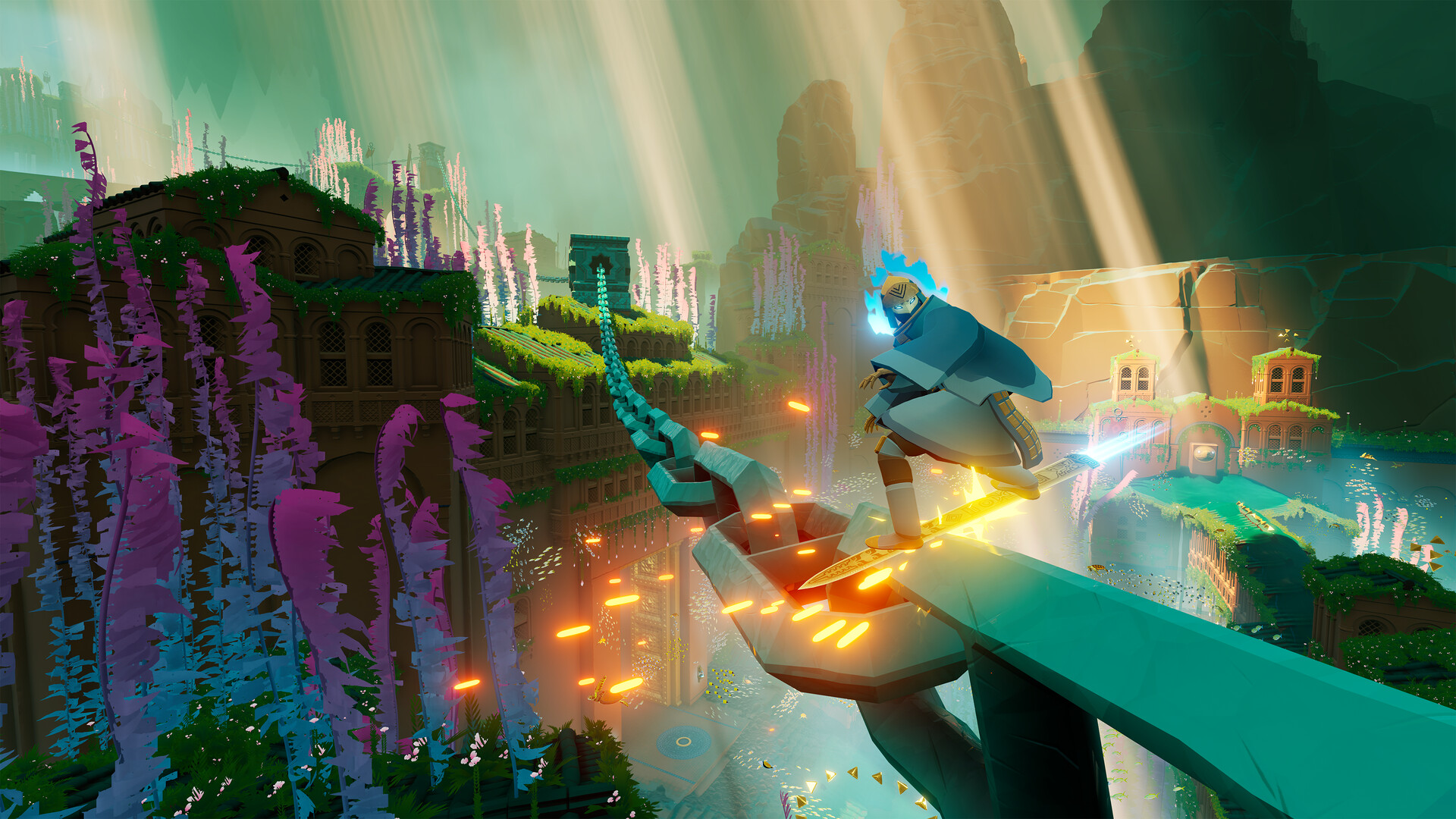
Occasionally, it’s enjoyable to play a game that lets you lose yourself for a couple of hours without needing to tackle complex challenges. While I appreciate tough boss fights and intricate puzzles like anyone else, there are times when I prefer a more relaxed gaming experience, and Sword of the Sea is perfect for that, offering the chance to effortlessly explore a stunning virtual world.
In a desert world shrouded in antiquity, you find yourself assuming the role of a guardian awakened from slumber. Essentially, your mission is to transform this sandy realm into something less arid. To accomplish this, you’ll use your sword much like a surfboard, gliding effortlessly over the dunes with a remarkably intuitive and gratifying movement system. Every now and then, you’ll need to pause and engage in some light puzzle-platforming to keep things interesting.
To make progress, you’ll have to locate switches, dodge obstacles, leap over wide chasms, and so on. Your set of moves is quite straightforward – you accumulate momentum with basic movements, then amplify your jump’s power at varying levels, followed by a mid-air double-jump to maintain that momentum and cover more ground. If you need an extra boost, you can execute tricks to momentarily slow your fall and squeeze out a bit more distance.
In addition to its practical applications, this technique also offers entertaining possibilities. As you progress, you’ll encounter skatepark-like sections requiring you to jump, slide along walls, and perform stunts to increase your combo and aim for a high score within a specified time frame. These additional challenges are optional, but they demonstrate that the movement system is more complex than it initially appears.

The payoff for accomplishing everything – hitting each small milestone – is witnessing a barren desert landscape gradually metamorphose into a lively, stunning ocean. Instead of harsh, bright browns, you’ll see glowing blues and greens, teeming with a diverse array of colorful marine life swimming in the water as well as through the air, much like stars twinkling in the night sky.
After observing sand for extended periods, witnessing the transformation is truly awe-inspiring. However, the game provides a tactile element to this visual delight through a straightforward mechanism: when you move across water, your speed increases. This subtle boost serves as a reward for your dedication in revitalizing the area. You’ll find yourself propelled forward at a quicker pace, granting you temporary momentum that carries you to the next stage where you will continue your mission all over again.
As a devoted player, I can confirm that’s the end of our three-hour loop! The game keeps things engaging by occasionally introducing fresh movement mechanics and a diverse range of environments – deserts, icy landscapes, and lava worlds. These captivating visuals ensure they never become monotonous.
In addition, the narrative adopts a minimalistic style, providing essential lore and world history through various nodes. Along the primary journey, it’s a straightforward story about two individuals meeting in an unfamiliar world to face a seemingly overwhelming force. The cutscenes are concise yet impactful, and despite lacking combat, the climax delivers a satisfying finale with a sort of final boss, making it an enjoyable experience overall.

The game’s puzzles aren’t overly complex, yet they maintain a laid-back atmosphere which aligns perfectly with its intended design. Surprisingly, it doesn’t shy away from stimulating your gaming instincts as well. A straightforward currency is gathered by discovering treasure chests scattered across the world. This currency can be used to purchase new tricks and minor additions to movement. Although these features don’t significantly alter the overall gameplay, they serve as a fun diversion that occasionally steers you away from the conventional path. They keep your mind active enough to prevent boredom.
After completing the game for the first time, it presents an opportunity for improvement. Following the ending, a stats display appears, revealing the time taken to finish the game along with your total trick tally throughout the game, providing a final overall score. Since my initial playthrough, which lasted roughly two and a half hours, sparked a desire within me to replay it quickly in order to achieve a higher score.
The game delays introducing this concept until your initial playthrough is complete. It’s deliberately designed so that you can immerse yourself fully in the game world during your first encounter. Once you’ve had that immersive experience, it offers additional features such as a speedometer and score counter if you wish to replay with a competitive focus.
Similar to Abzu, Sword of the Sea is an uncomplicated game that’s definitely worth spending your time on, given its brevity. It’s one of those soothing titles that you can easily fit into a single evening, allowing you to relax and enjoy its rewarding gameplay, stunning graphics, and leisurely difficulties.
More reviews on DBLTAP:
Read More
- Gold Rate Forecast
- Fed’s Rate Stasis and Crypto’s Unseen Dance
- Baby Steps tips you need to know
- WELCOME TO DERRY’s Latest Death Shatters the Losers’ Club
- Ridley Scott Reveals He Turned Down $20 Million to Direct TERMINATOR 3
- Blake Lively-Justin Baldoni’s Deposition Postponed to THIS Date Amid Ongoing Legal Battle, Here’s Why
- The VIX Drop: A Contrarian’s Guide to Market Myths
- Northside Capital’s Great EOG Fire Sale: $6.1M Goes Poof!
- BTC Dumps to $90K, HYPE Crashes 9%-What’s Next? 🚀💥
- Top 10 Coolest Things About Indiana Jones
2025-08-22 18:50